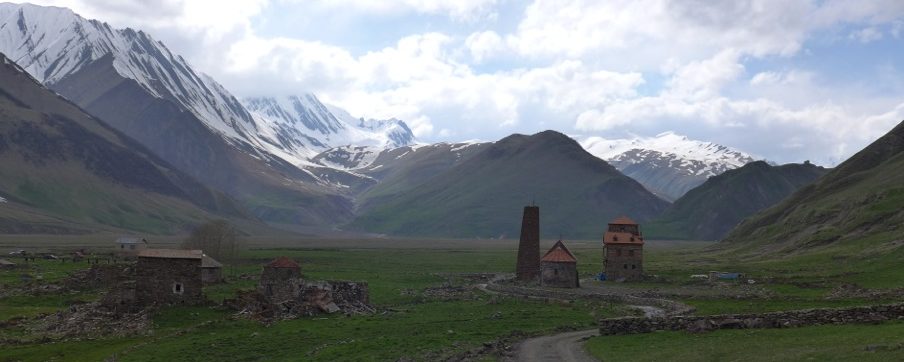
Your author experienced his first grape harvest in a small Georgian village called Nukriani on the outskirts of famed Signaghi. The process was incredibly simple. We arrived mid-afternoon on a sunny September day with a light breeze. The vineyard owner, the grandfather of a Georgian friend, promptly handed us a variety of pruning tools along with some buckets. He pointed to the small vineyard in his backyard, showed us the manual crusher in his garage, and gestured to his watch, indicating we had about an hour to get it done before dinner.

Within minutes, we found ourselves experiencing the “cognitive flow” popularized by Mihaly Csikszentmihalyi – those moments when you’re completely absorbed in a challenging but doable task that gives you great satisfaction. We each walked to the end of a row and, working backwards, clipped beautiful, large, ripe Rkatsiteli clusters from the tender shoots emanating from burly, twisted trunks. When the buckets were full, we wandered past a giant pig back to the garage, where the grandfather manned an ancient-looking manual crusher that seemed like a fusion of sausage press and wheelbarrow in one. Using an iron hand crank, the steel teeth just barely broke the skins of the grapes as we poured them into the opening, dropping the mashed grapes, skins and some stems included, six feet down into the clay qvevri buried beneath our feet. We repeated this process over a dozen times, almost completely in silence, until we’d filled the qvevri nearly up to its neck.

At this point we asked him what happened next. Expecting to hear a description of complex chemistry and technical terminology (unintelligible to your author in both English and Georgian at the time), he essentially stated that he did nothing for the next six months, other than “stirring” the wine twice a day. In other words, he punches down the “cap” of stems/skin that inevitably rise to the top of the must during fermentation and otherwise just lets the wine do its thing: no added yeasts, no added sulfites, and no added sugars. Eventually, the skins and stems fall to the bottom of the qvevri, leaving clear-ish wine on top. He ladles this into a new qvevri, tops it up with wine from prior years to avoid oxidation, lets it settle a few more months, and then drinks it. And his finished product tastes fantastic, year after year.

Looking around the house, garage, and dirt courtyard, we couldn’t help but realize that this was the way it was always done in this family, and in Georgia for that matter. The garage had embroidered frames of Stalin attached to the cold, concrete walls. One frame holds the black and white photos of all the Nukriani men who died during WWII. And my friend’s great-grandfather planted nearly all of the trees in the yard before he left for (and died in) the war.

While toasting to family, country, each other, and lost loved ones during dinner as dusk approached, I realized that this was the “tipping point” experience we’d been waiting for. It spurred us to try our own backyard vineyard in Maryland upon returning to America using the lessons on simplicity we’d learned in Georgia. While we certainly don’t have as ideal terrain as eastern Georgia, we make do and have a lot of fun doing it.
The approach is simple: grow the best grapes possible, celebrate harvest with family, allow as much skin and stem contact as possible, and don’t intervene. Just let time do its thing.
A backyard vineyard is more than a hobby – it is a way of life. You’ll find yourself more connected to your land, your family, your surroundings, and the cycle of life as a result. We hope you consider diving in after reading some of these posts.
